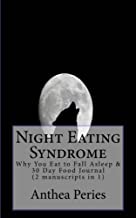Night Eating Syndrome
Night eating syndrome (NES) is an eating disorder, characterized by a delayed circadian pattern of food intake.[1] Although there is some degree of comorbidity with binge eating disorder,[1] it differs from binge eating in that the amount of food consumed in the night is not necessarily objectively large nor is a loss of control over food intake required. It was originally described by Albert Stunkard in 1955[2] and is currently included in the other specified feeding or eating disorder category of the DSM-5.[3] Research diagnostic criteria have been proposed[1] and include evening hyperphagia (consumption of 25% or more of the total daily calories after the evening meal) and/or nocturnal awakening and ingestion of food two or more times per week. The person must have awareness of the night eating to differentiate it from the parasomnia sleep-related eating disorder (SRED). Three of five associated symptoms must also be present: lack of appetite in the morning, urges to eat at night, belief that one must eat in order to fall back to sleep at night, depressed mood, and/or difficulty sleeping.
Cluster Number:
Wiki Number: PW135
Diagnosis: Night Eating Syndrome
US Patients: 1-2%; approximately 10% of obese persons
World Patients:
Sex Ratio:
Age Onset:
Brain Area: Reduced serotonin in the brain may be a factor
Symptoms: lack of morning appetite; urges to eat at night; belief in needing to eat to fall back asleep; depression;
difficulty sleeping
Progression: likely have 25+% of calories consumed after the evening meal; occurs more than twiceor more per week
Causes: The person is fully awake while eating, this is not “sleep-eating.”
Medications:
Therapies: Eating foods high in serotonin (bananas) or tryptophan (turkey) , but these do not affect serotonin or
tryptophan in the brain
Youtube Video: Night Eating Syndrome: The Solution
Amazon or Library Book: Night Eating Syndrome:
Why You Eat To Fall Asleep & 30-Day Food Journal
Click the book to link or buy from Amazon.

